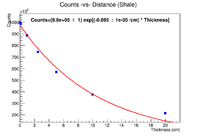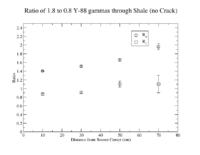Difference between revisions of "TF IsotopeTracers4Cracks"
| Line 17: | Line 17: | ||
y-intercept=13.4456 +/- 0.102718 | y-intercept=13.4456 +/- 0.102718 | ||
| − | but the curve from these parameters was too low to believe. It is not worth the time right now to figure out what is wrong. | + | but the curve from these parameters was too low to believe. It is not worth the time right now to figure out what is wrong. I will argue that the fit by hand which gives 0.1/cm is enough indication that GEANT4 is correctly attenuating the photons. |
=Yittrium in Shale= | =Yittrium in Shale= | ||
Revision as of 20:57, 21 March 2013
Photon Attenuation in Shale
The attenuation length for a 1.8 MeV photon is 0.16 /cm and 0.895 is 0.22/cm through shale.
File:XCOM attenuation4Shale.pdf
Directing a 1.8 MeV beam of photons in GEANT4 towards various thicknesses of shale produced the graph below.
XCOM predicts an attenuation coefficient of 0.0441 cm^2/g which becomes 0.12/cm when you multiply by the shale density of 2.6 g/cm^3. The fit to GEANT4's predictions above produces a value of 0.1/cm when you plot the number of photons that pass through the shale and still have an energy of 1.8 MeV. A least squares fit gave the parameters
slope=-0.118033 +/- 0.0423836 y-intercept=13.4456 +/- 0.102718
but the curve from these parameters was too low to believe. It is not worth the time right now to figure out what is wrong. I will argue that the fit by hand which gives 0.1/cm is enough indication that GEANT4 is correctly attenuating the photons.
Yittrium in Shale
A simulation of the penetration of the 0.895 and 1.8 MeV photons from Yittrium through shale.
GEANT4 create a point source or 895 keV photon and another with 1800 keV photons iostropically distributed.
A 4" thick piece of shale was placed between the source and the detector.
shale was defined as:
G4Element* O = new G4Element("Oxygen" , "O", z=8., a= 16.00*g/mole);
G4Element* Al = new G4Element("Aluminum" , "Al", z=13., a= 26.98*g/mole);
G4Element* Si = new G4Element("Silicon" , "Si", z=14., a= 28.085*g/mole);
G4Element* H = new G4Element("Hydrogen" , "H", z=1., a= 1.008*g/mole);
G4Material* Shale = new G4Material("Shale", density= 2.6*g/cm3, nel=4);
Shale->AddElement(Al, 15*perCent);
Shale->AddElement(Si, 15*perCent);
Shale->AddElement(O, 38*perCent);
Shale->AddElement(H, 32*perCent);
Two ratios were constructed.

